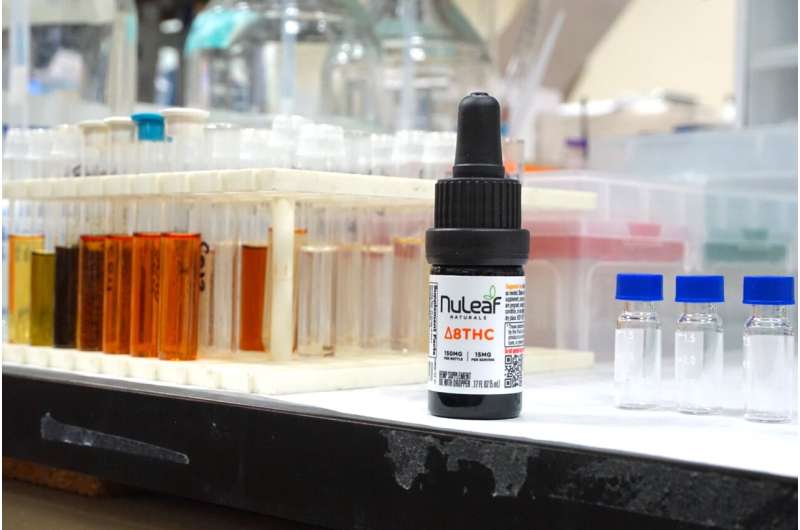
A sharp rise in exposures to synthetic cannabis products among youth—some leading to hospitalization—highlights the need for increased education around the dangers of exposure and increased focus on safe storage and packaging, according to pediatricians and researchers at Nationwide Children’s Hospital and the Central Ohio Poison Center.
A new study conducted by researchers at the Center for Injury Research and Policy of the Abigail Wexner Research Institute at Nationwide Children’s Hospital and the Central Ohio Poison Center examined trends in calls to poison centers across the country for exposures to different types of tetrahydrocannabinol (THC): delta-8 THC, delta-10 THC and THC-O acetate. These products are often referred to as “diet weed” or “hemp products,” which leads to a misperception that they are safer alternatives to the more regulated and more abundant delta-9 THC.
The study, published in Clinical Toxicology, found increases in the number of exposures in multiple age groups, with unintentional ingestions by young children being especially concerning.
“Many people don’t realize how toxic these products can be, especially to young children. One in four children needed to be hospitalized after exposure,” said Hannah Hays, MD, co-author of the study, medical director of the Central Ohio Poison Center and faculty of the Center for Injury Research and Policy at Nationwide Children’s.
“If someone vapes, smokes, eats edibles or drinks infused beverages with delta-8, delta-10 THC or THC-O, all of those products should be stored up, away, and out of sight and reach of children, preferably in a locked container.
“These products should never be used in front of kids who might mistake them for food or drinks that they are allowed to have.”
According to the study:
- U.S. poison centers received 1,746 calls related to delta-8 THC, delta-10 THC, and THC-O acetate exposures in 2021. This number increased by 88% to 3,276 in 2022—an average of one call every 2.6 hours.
- Most cases were single-substance (94%), ingestions (94%) that occurred at a residence (96%) in 20–59-year-olds (40%), 6-year-olds (31%), and 6–19-year-olds (25%). The most common clinical effects were mild central nervous system depression (when signals from the brain and spinal cord decrease) (25%), rapid heartbeat (23%), and agitation (16%). Other clinical effects included moderate central nervous system depression (11%), confusion (7%), hallucinations/delusions (4%) and ataxia (uncoordinated movement) (3%).
- More than one-third (38%) of cases experienced a serious medical outcome and 16% were admitted to a health care facility. Children <6-years-old accounted for roughly half of those admissions (58% of critical care admissions and 49% of non-critical care admissions).
Safe storage
Pediatricians and other health care providers should continue to counsel patients and their families about the potential dangers of these products and the importance of safe storage practices, experts recommend:
- Talk to children about cannabis-related products. Have age-appropriate conversations with children about cannabis-related products, explaining what these products are and why they can be dangerous.
- If these products are in the home, store them safely. The best way to keep children safe from cannabis-related products is to keep them out of the home. If these products are kept in the home, store them in a safe place away from your children—stored up and out of sight, away from food, and locked if possible.
- Don’t use these products in front of children. It is helpful to never use these products in front of your children, especially if packaged to look like treats.
- Talk to friends, family, and other caregivers. Talk with caregivers around your child about cannabis-related products and how to keep these products away from your children. Save the national Poison Help Line number (1-800-222-1222) in your phone and post it in a visible place in your home. The Poison Help Line provides free, confidential advice from experts, 24 hours per day, seven days per week.
Safe packaging
Study investigators also highlight inconsistent regulations of these products from state to state. Because the United States Food and Drug Administration currently does not regulate manufacturing of these products, contaminants such as heavy metals, solvents or pesticides may be found in them and may not be listed on product packaging.
In addition, in many states, these products may not have the packaging or labeling requirements that delta-9 THC products have.
While at least 14 states have banned or regulated the sale of these products, they are still available to the public online and in locations like gas stations and small convenience stores. In many places, there may be little to no regulation, with retailers often setting their own minimum purchasing age.
“The current patchwork of state regulations has led to an environment that allows for easily available products that may have unlisted contaminants, inaccurate labels and packaging that can be appealing to children” said Christopher Gaw, MD, co-author of the study, pediatric emergency medicine physician and faculty member of the Center for Injury Research and Policy at Nationwide Children’s.
“We need clearer regulation of these products with better oversight and enforcement.”
More information:
Alice Burgess et al, Delta-8 tetrahydrocannabinol, delta-10 tetrahydrocannabinol, and tetrahydrocannabinol-O acetate exposures reported to America’s Poison Centers, Clinical Toxicology (2024). DOI: 10.1080/15563650.2024.2340115
Citation:
New study finds increase in exposures to synthetic tetrahydrocannabinols among young children, teens, and adults (2024, May 7)
exposures-synthetic-tetrahydrocannabinols-young-children.html
.
. The content is provided for information purposes only.
